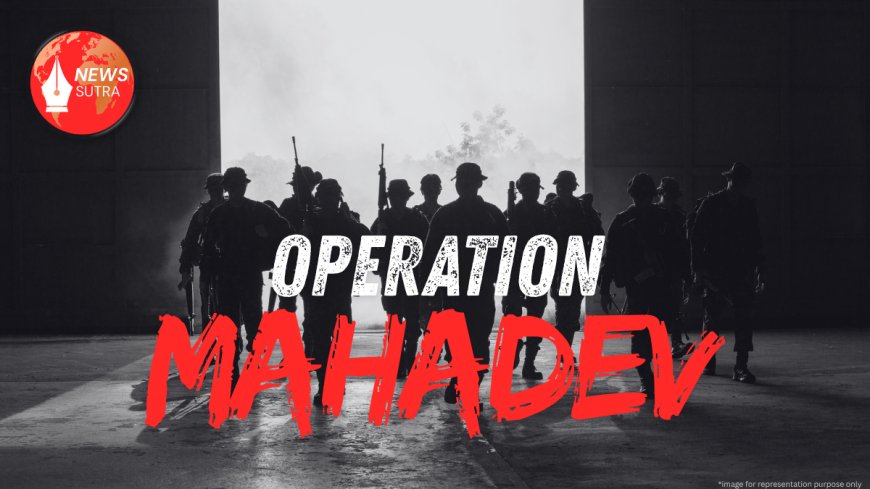Operation Mahadev: How India Tracked and Eliminated the Pahalgam Attack Mastermind in a Strategic Strike
Operation Mahadev saw Indian special forces eliminate Pahalgam attack mastermind Suleiman Shah and two associates through precise intelligence-led action, marking a critical breakthrough in counter-terrorism in Jammu & Kashmir.

In a meticulously executed counter-terrorism mission in the forests near Srinagar, Operation Mahadev culminated in the elimination of three terrorists, including Suleiman Shah (alias Hashim Musa)—the alleged mastermind behind the deadly April 22 Pahalgam attack. This operation, launched after 14 days of targeted surveillance and intelligence gathering, highlights India’s evolving precision-based security strategy in Jammu & Kashmir.
Intelligence to Action: The Build‑Up to Operation Mahadev
Security agencies initiated the operation following interception of an encrypted ultraset call on July 26, prompting a mobile tracking response toward the Harwan–Lidwas region near Dachigam National Park www.ndtv.com+12www.ndtv.com+12The Times of India+12.
Over two weeks, the Rashtriya Rifles, J&K Police, and Para Special Forces monitored the site. At 2 a.m. on July 28, when the device signaled activity, a drone reconnaissance was launched. By 9:30 a.m., commandos ascended the terrain and engaged in the encounter, neutralizing all three suspects within 30 minutes and securing the site by noon www.ndtv.com+1Wikipedia+1.
The Target: Suleiman Shah and His Network
Suleiman Shah—formerly a Pakistani Army SSG commando turned LeT operative—is alleged to have orchestrated the Pahalgam massacre that claimed 26 tourist lives and one local. Also killed were Abu Hamza and Yasir, believed to be part of his inner cell planning future attacks www.ndtv.com+3Wikipedia+3www.ndtv.com+3. The recovery of arms—including AK‑47s, an M4 carbine, and 17 rifle grenades—established the trio as high-value militant assets Instagram+5www.ndtv.com+5www.ndtv.com+5.
Operation Execution: Precision and Coordination
The operation was marked by swift decision-making, multi-agency coordination, and the use of real-time drone imagery. Within hours, field teams visually identified targets, engaged decisively, and commenced area sanitization, which included securing weapon caches and documenting the site www.ndtv.comThe Economic Times.
Local authorities confirmed that identification of the deceased has been performed, and legal formalities managed under existing SOPs The Times of India.
Public Time and Tactical Response: Filling a Mental Space
For victims' families, the operation offered a semblance of closure. Aishanya Dwivedi, whose husband Shubham died in the Pahalgam attack, remarked:
“The pain will not go, but at least some peace will come to us… I have faith in our Indian Army” Wikipedia+15www.ndtv.com+15Instagram+15.
Top officials, including Lieutenant Governor Manoj Sinha, lauded the forces for carrying out the mission with surgical precision and minimal collateral risk. The operation also served as a strategic message: militant planners will be relentlessly pursued The Economic Times.
Strategic Significance: What Operation Mahadev Represents
-
Counter‑Narrative to Terror Tolerance
The swift hunt for Shah undermines narratives of militant immunity and reinforces the efficacy of India’s intelligence apparatus. -
High‑Value Target Neutralisation
Taking down a Pakistan-trained commando turned LeT operative has legal and symbolic significance, potentially degrading the operational capabilities of militant networks. -
Integration of Tech and Terrain
The use of encrypted communication interception, drone visuals, and mountain warfare tactics illustrates evolving synergy between ISI-accredited intelligence, local terrain knowledge, and force readiness.
Lessons Learned and Operational Insights
| Insight | Description |
|---|---|
| Surveillance Tech Works | Hours of audio tracking via ultraset devices can unmask concealed cells over treacherous terrain. |
| Drone Reconnaissance Is Essential | Unmanned aerial platforms provided visual authentication on difficult mountain terrain ahead of the strike. |
| Inter-Agency Cohesion Matters | Coordination between Rashtriya Rifles, Para SF, CRPF, and local police streamlined mission execution. |
| Minimal Exposure, Maximum Impact | The operation achieved its objectives in under three hours, ensuring tester safety and swift aftermath operations. |
Future Implications for Jammu & Kashmir Security
Operation Mahadev reinforces confidence in India’s counter-terror doctrine.
-
Local security grid and intelligence-sharing channels are expected to tighten.
-
Future operations may adopt similar small-footprint, high-impact tactics emphasizing surveillance and rapid field execution.
-
Enhanced surveillance in forest adjacency areas like Dachigam is likely to become the norm to prevent renewed infiltration cycles.
Conclusion: Operation Mahadev’s Broader Resonance
This mission demonstrates a calculated shift—from broad counter-insurgency sweeps to targeted precision operations. By neutralizing a high-value planner of the Pahalgam massacre, the operation reflects an intensified security posture—one where intelligence-driven action meets operational agility.
India’s security machinery has signaled that no terrorist plot goes unpunished. Operation Mahadev stands as a marker of accountability, underscoring both resolve and tactical sophistication in safeguarding the nation.




















































